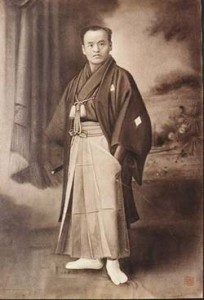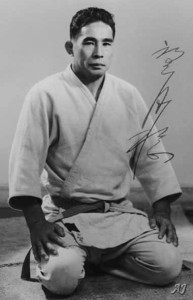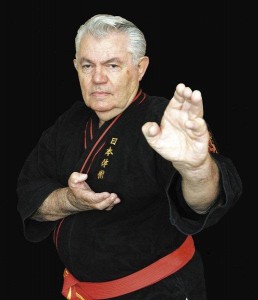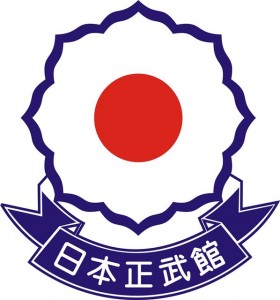What is Nihon Tai Jitsu?
Principles used within Nihon Tai Jutsu are:
– Parries made in the move
– Actions applied on joints and tender points
– Techniques starting from a distance of the opponent and always preceded and followed by strikes
The techniques are classified wisely to be easier to learn. Nihon Tai Jitsu can be practiced by all and does not include violent falls or competition.
Never forget that Nihon Tai Jutsu is a set of techniques of self-defense and not a means of attack. The defense is unarmed against one or more armed or unarmed opponents.
History of Nihon Tai Jutsu
 The origins of our discipline can be traced back to the ninth century with the creation in Japan of the School DAITO RYU.
The origins of our discipline can be traced back to the ninth century with the creation in Japan of the School DAITO RYU.
In this school the samurai warriors of Takeda Clan learned arts of combat with and without weapons. Over the centuries, the Daito Ryu school was improving its techniques and enhancing its reputation, until the late XIX century (Meiji era), when because of the Imperial order the samurai caste was abolished losing their privileges, including exclusive use of weapons. At that time one of the last masters of the School, Sokaku TAKEDA, decides to teach people outside the clan, the techniques of his school.
 Among the selected group of persons to whom were directly taught the secrets of the School, was Master Morihei UESHIBA (creator of AIKIDO). UESHIBA sensei changed the teachings received from TAKEDA sensei in a more philosophical than martial discipline, the AIKIDO, but before that he transmitted to some of his students the original teachings of the Daito Ryu school. Minoru MOCHIZUKI sensei was one of them, direct student of Jigoro KANO sensei (creator of JUDO), he was sent by him to study with renowned masters of Ju-Jutsu old schools, including UESHIBA sensei. With him he studied DAITO RYU AIKI JUJUTSU and AIKIDO. In UESHIBA’s Dojo he met Sokaku TAKEDA, although he never studied directly with him.
Among the selected group of persons to whom were directly taught the secrets of the School, was Master Morihei UESHIBA (creator of AIKIDO). UESHIBA sensei changed the teachings received from TAKEDA sensei in a more philosophical than martial discipline, the AIKIDO, but before that he transmitted to some of his students the original teachings of the Daito Ryu school. Minoru MOCHIZUKI sensei was one of them, direct student of Jigoro KANO sensei (creator of JUDO), he was sent by him to study with renowned masters of Ju-Jutsu old schools, including UESHIBA sensei. With him he studied DAITO RYU AIKI JUJUTSU and AIKIDO. In UESHIBA’s Dojo he met Sokaku TAKEDA, although he never studied directly with him.
 Throughout his life, Master Minoru MOCHIZUKI studied various old school and styles of combat: JUDO with Jigoro KANO and Kyuzo MIFUNE, DAITO RYU AIKI JUJUTSU and AIKIDO with Morihei UESHIBA, SHOTOKAN KARATE with Gichin FUNAKOSHI, KARATE RYU SHORINJI with Masayuki HISAKATA, KENDO with Toku SANBO, IAIDO and KENDO with Hakudo NAKAYAMA, SHINDO MUSO RYU (school of Jojutsu) with Takaji SHIMIZU and KATORI SHINTO RYU (school of bujutsu) with Yazaemon HAYASHI.
Throughout his life, Master Minoru MOCHIZUKI studied various old school and styles of combat: JUDO with Jigoro KANO and Kyuzo MIFUNE, DAITO RYU AIKI JUJUTSU and AIKIDO with Morihei UESHIBA, SHOTOKAN KARATE with Gichin FUNAKOSHI, KARATE RYU SHORINJI with Masayuki HISAKATA, KENDO with Toku SANBO, IAIDO and KENDO with Hakudo NAKAYAMA, SHINDO MUSO RYU (school of Jojutsu) with Takaji SHIMIZU and KATORI SHINTO RYU (school of bujutsu) with Yazaemon HAYASHI.
In 1931, with the consent of their Masters, he opened his school of martial arts, the YOSEIKAN Dojo in Shizuoka, his hometown, and in 1951 he was sent to France on behalf of the Kodokan and the Aikikai. He remained in Europe until 1954, especially in Paris, teaching his particular technique, a cluster of knowledge that he called AIKIDO JUJUTSU, to a group of people, including the young Frenchman of Algerian origin Jim ALCHEIK. When MOCHIZUKI sensei returned to Japan, Jim ALCHEIK traveled to Japan for three more years studying at the dojo YOSEIKAN of Minoru MOCHIZUKI in Shizuoka. MOCHIZUKI sensei considered to Jim ALCHEIK as his own representative for Europe and he asked him to create the French Federation of Aikido, and TAI-JITSU KENDO (FFATK) at his return to Japan, what he did in 1957, also devoted to teaching these three disciplines. His TAI-JITSU was a method of self-defense based on the techniques he had learned from MOCHIZUKI sensei.
Roland HERNAEZ
Jim ALCHEIK had three assistants, one of them, Roland HERNAEZ, looked particularly at the TAI-JITSU. Unfortunately, Jim ALCHEIK died in 1962 by an explosion during an attack in the Algerian war. After his death, his students dispersed, each one working the part that was nearest them pedagogically.
 Roland HERNAEZ was born in 1934, he began his career in the martial arts in 1951 with JUDO (Mikonosuke KAWAISHI and Luc LEVANIER) and JU-JITSU. He did the military service at Fort Carré in Antibes and he practiced Close Combat, which became an instructor. In 1956 he obtained his black belt in judo, and began the practice of karate (Henry PLEE and MURAKAMI), Aikido (Hiroo MOCHIZUKI, and Tadashi ABE) and the TAI-JITSU that he discovers with Jim ALCHEIK, continuing later with Minoru MOCHIZUKI.
Roland HERNAEZ was born in 1934, he began his career in the martial arts in 1951 with JUDO (Mikonosuke KAWAISHI and Luc LEVANIER) and JU-JITSU. He did the military service at Fort Carré in Antibes and he practiced Close Combat, which became an instructor. In 1956 he obtained his black belt in judo, and began the practice of karate (Henry PLEE and MURAKAMI), Aikido (Hiroo MOCHIZUKI, and Tadashi ABE) and the TAI-JITSU that he discovers with Jim ALCHEIK, continuing later with Minoru MOCHIZUKI.
When Jim ALCHEIK died, he prepared to set up a method of self-defense, from the teachings of ALCHEIK. In 1967, within the “Budo Academy”, the association of TAI-JITSU, he began to bring together some educators who were working quietly and effectively.
For Roland HERNAEZ, Jim ALCHEIK was an excellent budoka, however there was a point in his teaching with which he disagreed, the lack of rigor in his methodology. After having been repeatedly training with Minoru MOCHIZUKI, he encouraged him to develop a more cartesian method of TAI-JITSU.
In 1972, he traveled to Japan at the invitation of the Japan Publication, a publisher, to develop their skills in SHORINJI KEMPO, wich he already knew for having trained in it previously, with his brother George HERNAEZ and Daniel DUBOIS. They trained three weeks in the temple of Shikoku. Master HERNAEZ was very attracted to this school and back to home he hosted at his house a teacher of Shorinji Kempo (Master Hiroshi AOSAKA) for two years. During this time, he trained with him several hours each day. He became the first black belt of SHORINJI KEMPO of the West. SHORINJI KEMPO contributed much; Roland HERNAEZ drew from it many things to enrich his TAI-JITSU, but he was unable to continue with the discipline because it meant a deepening religious aspect – the kongo zen – with which he did not agree.
Returning from Japan, Roland HERNAEZ founded the FRENCH TAI-JITSU AND SHORINJI-KEMPO FEDERATION, of which he was president for the first two years. Then both disciplines separated to follow their own ways, Roland HERNAEZ focusing since then only on TAI-JITSU.
In Japan, Roland HERNAEZ introduced MOCHIZUKI sensei to the result of their work on establishing a teaching methodology that would follow Cartesian principles for a coherent learning of the old techniques of TAI-JITSU. With this end HERNAEZ sensei had established technical groups of Kata and techniques to facilitate learning for Westerners, obtaining recognition of Minoru MOCHIZUKI. During this visit the MOCHIZUKI sensei authenticated the methodology of the Roland HERNAEZ as traditional and formal, with the name of NIHON TAI-JITSU, and he appointed him its representative in Europe.
Tai Jitsu and Nihon Tai Jitsu
Over time some groups that did not adapt to the technical and methodological developments undertaken by the Master HERNAEZ were distancing themselves from the official line of NIHON TAI-JITSU, with a separation between the groups working a TAI-JITSU nearest KARATE schools and those working a NIHON TAI-JITSU nearest schools NIHON JU-JITSU. In 1985 this separation between both schools was endorsed by the Japanese masters in Shizuoka (Japan) differentiating TAI-JITSU from NIHON TAI-JITSU like martial arts that originally, like many others, had a common intersection, but that with the time followed different paths. But the International Federation attempted to cover all of these organizational groups within it to keep some of them, while others decided to create their own organizations and to initiate an independent path..
International recognition
NIHON TAI-JUTSU is recognized by KOKUSAI BUDOIN – International Martial Arts Federation, an organization created on the day following the end of World War II and was directed by the greatest masters of different disciplines, such as the Master Minoru MOCHIZUKI and Master Shizuo SATO for JU-JITSU, Master SUGINO for Katori Shinto-Ryu, and Master MIFUNE for Judo. Some sadly died later.
NIHON TAI-JUT SU has also been recognized by the SEIBUKAN ACADEMY / ALL JAPAN BUDO FEDERATION of Kyoto, which was led for a long time by Master SUZUKI, 10th dan Goju-Ryu karate, as well as the IFNB (International Federation of Nihon Budo ) of Master Minoru MOCHIZUKI.
SU has also been recognized by the SEIBUKAN ACADEMY / ALL JAPAN BUDO FEDERATION of Kyoto, which was led for a long time by Master SUZUKI, 10th dan Goju-Ryu karate, as well as the IFNB (International Federation of Nihon Budo ) of Master Minoru MOCHIZUKI.
Master Roland HERNAEZ, is the technical director of the FMNITAI and he is 10th dan Shihan Hanshi NIHON TAI-JUTSU of SEIBUKAN ACADEMY / ALL JAPAN BUDO FEDERATION the highest possible level within the Japanese Budo, awarded in recognition of services rendered to BUDO. He is also officially 4th dan in Judo, 4th dan in Aikido, 8th dan in Karate-Jutsu / Nihon Tai JUtsu, 1st dan in Shorinji-Kempo.
In his words we can found what has been the essence of their work by NIHON TAI-JUTSU:
“Today I am proud to say that this method of self-defense, born of the samurai JU-JITSU, is respected throughout the world that recognize its effectiveness, its progression, its principles, its hierarchy and its particular spirit. The Japanese Masters, among the heirs of the largest BUDO traditional figures with which I am in contact for years, gave to my method the label NIHON (authentically Japanese) that our practitioners use proudly. Associated with the NIHON JU-JUTSU of the International Federation of Martial Arts, our style is recognized and appreciated by these masters holders of the Imperial Japanese recognition. The honorary president of the Federation was the emperor’s uncle, Prince HIGASHIKUNI. Each year the Japanese Masters which I study shows me his affection, and I had the honor of being named in the course of practice in Munich (October 1992) 8th dan of Nihon Ju-Jutsu, the highest grade awarded to this BUDO to a Westerner. My method is primarily a Martial Art that is part of BUDO traditional, but also it is a particular conception of self-defense to all, born of the real JU-JUTSU, descending from Masters KANO, MIFUNE, ITO, KAWAISHI, MOCHIZUKI, SATO, KAWANO. In our times of trouble where the emphasis is placed on the competition, I think it is vital to the future of man to encourage anything that might contribute to harmony and peace. If NIHON TAI-JITSU, as I made it, can make a stone of this building, it will be my best reward and hope in a life of progress”.